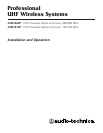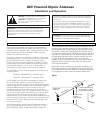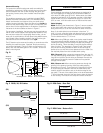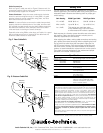
UHF Powered Dipole Antennas
Installation and Operation
CAUTION! The circuits and wiring inside the antennas are
adjusted for optimum performance. Do not attempt to alter
circuitry or wiring to affect output. To do so will void the
warranty and may cause improper operation or system
degradation.
This device complies with part 15 of the FCC Rules. Operation is
subject to the condition that this device does not cause harmful
interference.
This device complies with INDUSTRY CANADA R.S.S. 210, en
conformité avec IC: RSS-210/CNR210. Operation is subject to
the following conditions: 1) This device may not cause harmful
interference and 2) this device must accept any interference
received, including interference which may cause undesired
operation.
Introduction
Audio-Technica ATW-A62P and ATW-A72P powered dipole
antennas provide effective and reliable signal pickup for UHF
wireless systems. Supplied in pairs, these antennas are intend-
ed to improve performance of diversity wireless receiving
systems with dual antenna inputs.
Designed for temporary or permanent installation, these anten-
nas are powered by 12 volts DC provided on the antenna cable
by the associated receiver or antenna distribution system.
Power is required for antenna operation; an indicator on each
housing lights when power is applied. An internal gain-setting
switch permits selection of +10, +4 or –2 dB operation, to
compensate for cable losses or other operating conditions.
The ATW-A62P and ATW-A72P are designed for particular UHF
frequency bands:
ATW-A62P: 656-668 MHz (TV channels 45-47)
ATW-A72P: 728-740 MHz (TV channels 57-59)
The ATW-A62P and ATW-A72P are designed for interior use.
Do not install them outdoors, or where condensation or
extremely high humidity is present. Both models permit several
means of mounting for temporary use or permanent installation.
Included AT8667 brackets with BNC connectors and
5
/
8
"-27
threaded mounts permit convenient use with conventional
microphone stands or other
5
/
8
"-27 threaded fixtures. The anten-
nas may also be permanently secured directly to walls or other
vertical structures, or they may be attached to single-gang
electrical boxes. The RF cables may be totally hidden by exiting
behind the antenna housings, or they may exit through an open-
ing at the bottom of each housing to be routed along the wall
or mounting structure.
Audio-Technica offers several optional RF extension cables: A
12' (3.6 m) RG58-type, plus 25', 50' and 100' (7.6, 15.2 and
30.5 m) RG8-type cables. All have BNC-to-BNC connectors.
Warning: To prevent fire or shock hazard, do
not expose this appliance to rain or moisture.
Attention: Pour prévenir feu ou choc
électrique, ne pas exposé l’appareil à la pluie
ou à l’humidité.
CAUTION! To prevent electrical shock and possible damage
to the antenna, use caution when connecting 12V power from
the receiver or antenna distribution system.
For best operation, the antennas should be mounted on a line-
of-sight to the most likely location(s) of the transmitter, while
also considering the shortest length of cable required to reach
the receiver. Usually this means placing the antennas well up
on a wall, above head height, and above the level at which they
might be hit or obstructed. The two antenna housings should
be mounted at the same height, oriented vertically, and with
at least 12" (30 cm) between them (Fig. A). As much as
possible, keep the antennas away from noise sources such as
digital equipment, motors and neon lights, as well as away
from large metal objects.
When determining a location for a permanent installation, it is
often a good idea to try the selected location temporarily with
the wireless system (and any other RF or computer equipment)
in full operation to confirm optimum system performance.
Antenna Location & Orientation
Fig. A
Transmitter
Location
12" minimum
Locate antennas away
from mirrors or other
large metallic surfaces
Unobstructed
position,
high on wall
Line-of-sight






